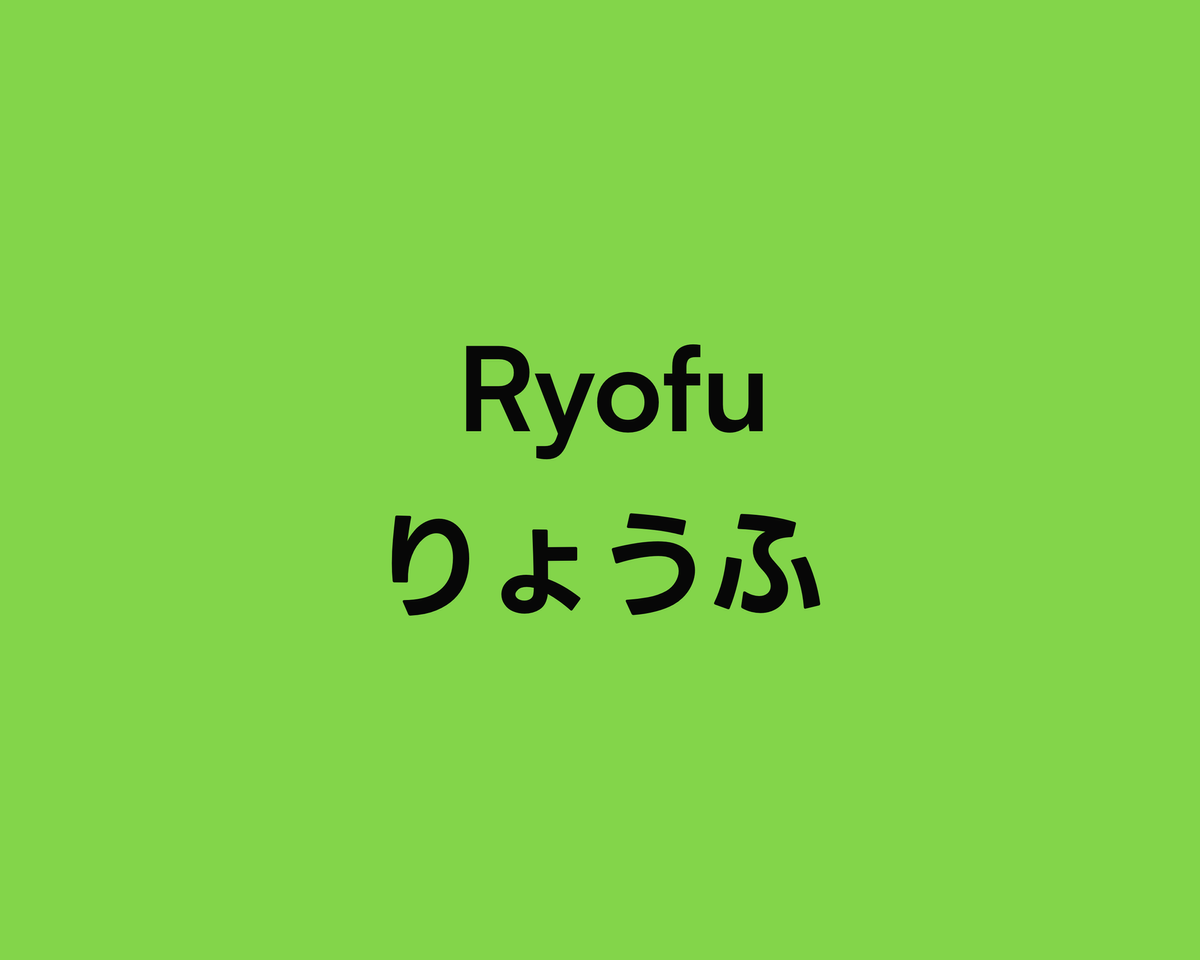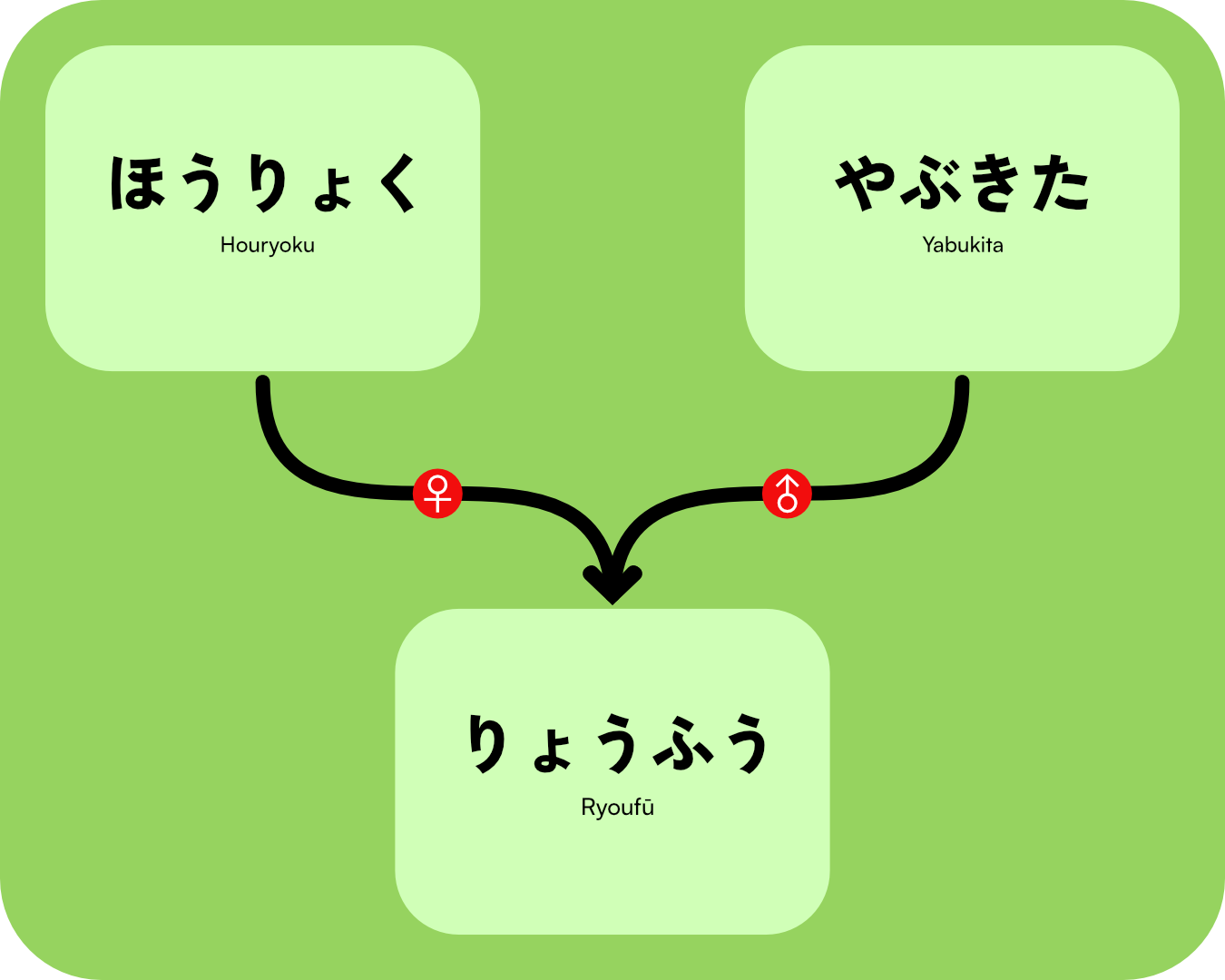Ryofu りょうふう
Ryofu was developed from a crossing of Houryoku as the flower component and with Yabukita as the pollen component in the tea research center of Kanaya in 1972.

Genealogy
♀: Houryoku ほうりょく
♂: Yabukita やぶきた

History
Ryofu was developed from a crossing of Houryoku as the flower component and with Yabukita as the pollen component in the tea research center of Kanaya in 1972. It was released to the public in 1997, when it was registered as a sencha cultivar nº45 in the MAFF registry. Then in 2001, it registered under the seed and seedlings registrar with reg number 9204. Its name derives from 涼風, meaning cool breeze.
The flower component of Ryofu, Houryoku, is derived from a seedling selection from Tada Motokichi’s material introduced from India. Houryoku was developed as part of the Shizuoka 4000 series, with Houryoku being 4018. It was selected out at the Shizuoka Kanaya National research centre as a cultivar from the assamica variety suited for green tea in 1943, and after its development, in 1956, it never got registered.
As for the development of Ryofu, after collecting the seeds in 1973, it underwent the field selection trials until 1979 with number 47-436. From 1980, it was propagated and again tested in a nursery. From there on, until 1987, its tea production traits were tested with the name F1 139. During 1988 until 1994, under the name Kanaya nº17, it was tested for regional adaptability, disease resistances, and production in multiple prefectures across the country. From Ibaraki in the northern limit of economical production all the way south to Kumamoto and Kagoshima, just to mention a couple, totaling up to 13 prefectures.
In 1996, it had excellent results in cold and disease resistance, as well as being an appropriate cultivar for tea production that also had mid-late growing characteristics. Subsequently, it was brought to consideration by the Committee that examines potential new cultivars. From there, revised and accepted by the Tea Industry Testing and Research Promotion Council in 1997, which started the process for filling it into the MAFF registry the same year. It can be obtained from licensed nurseries, and its usage is not limited to Japan.
Characteristics
Ryofu is a sencha cultivar with mid- to late-harvesting characteristics, resistance to cold and diseases, and the quality of the sencha tea is good. In the nursery, it roots well and is easy to propagate, with a reported 90% survival rate with some regional exceptions. The 3 first years of the tree’s growth are also good, with a tall shape and stretched stock shape. The growth behavior is similar to Yabukita in terms of growth timings, with a higher height and slightly more branches. Survival rate from nursery to field reported a 100% rate in almost all testing regions.
In terms of pests and other resistances, it is a cultivar resistant to cold and red blight, better handling this situation than Yabukita. Its reported resistance to anthracnose is moderate with better results than Yabukita on average, and slightly less resistant than Kanayamidori かなやみどり, another moderately resistant cultivar. Cold damage was only observed in a couple of testing sites; interestingly enough, the damage was observed in areas besides Ibaraki, situated at the northern economic limit for tea production. As for the funnily named but highly damaging mochi disease, Ryofu is stronger than Yabukita, but it is still susceptible in areas with poor ventilation and high humidity environments. It also appears easily after heavy rainy periods.
Budding is around the same time as Kanayamidori as well, an average of 4 days after Yabukita, placing Ryofu in the mid-late category of budding cultivars. As for the harvesting period is about 2–3 days after Yabukita. One of the reason to develop late growing cultivars is to spread out the harvesting times so to not overload the processing factories and more easily manage the labor, which is in shortage and seasonal.
The yield of Ryofu is about the same as Yabukita in its first harvestable year, but higher than that in subsequent years. It yields for first, second and third harvest are also higher than Yabukita. The release report for Ryofu expresses those value in harvested grams per square meter (g/m2), just to provide a point of comparison, the average harvested amount in spring was 482g/m2 for Yabukita and 533g/m2 for Ryofu, then 261 against 369 in summer and 188 against 236 in autumn. Kanayamidori was, again, on par with Ryofu, but amounting slightly more harvested leaves in spring. This could be perhaps, among other, due to the similar number of buds but with a longer length than the Yabukita buds.
The reported shape and appearance of the leaves just about the same as in Yabukita in terms of bud weight, length, and number. The increase in branching, leading to a thicker canopy, could be another explanation of a slightly higher yield. The Ryofu leaves are yellowish green with long and considered oval, with a medium size and not that glossy. One interesting reported characteristic is the better color of the leaf in the summer and Autumn compared to Yabukita and others, which can have a more reddish/brown colours in those harvesting periods.
The quality of the brewed tea was on average good, with similar results to Yabukita. Appearance is also around the ballpark of Yabukita, but with slightly less good shape than Yabukita. Brewed tea is clear with good colour, and was evaluated to be better than both Yabukita and Sayamakaori during the Summer and Autumn harvests as well.
One fun data point that at some point was introduced in the release reports for cultivars was a desirability or preferability score. In those, the prefecture can give sort of an opinion on how desirable the traits of this cultivar would be in the prefecture. Occasionally, a great tasting cultivar will take a hit in this section due to, for example, poor rooting, so perhaps not suited for certain prefectural soils for example. Ryofu got a 5 out of 5 in Saga and Kumamoto prefectures, with Kagoshima and Ibaraki at a close 4.7 and 4 respectively.
References
“品種登録迅速化総合電子化システム.” _Maff.go.jp_, 2025, www.hinshu2.maff.go.jp/vips/cmm/apCMM112.aspx?TOUROKU_NO=9204&LANGUAGE=Japanese. Accessed 10 Jan. 2025.
Kondo Sadaaki, et al. “New Released Green Tea Cultivar ‘Ryofu.’” Chagyo Kenkyu Hokoku (Tea Research Journal), vol. 1999, no. 87, May 1999, pp. 21–38. DOI.org (Crossref), https://doi.org/10.5979/cha.1999.21.
小栁津 勤(2004):静岡県における茶品種普及への取組み.野菜茶業研究集報,1,79-108. https://agriknowledge.affrc.go.jp/RN/2010700196
“4006 アッサム系緑茶用激レア品種.” _天竜楽市_, 29 June 2018, tenryu-rakuichi.amebaownd.com/posts/4457466/. Accessed 10 Jan. 2025.
